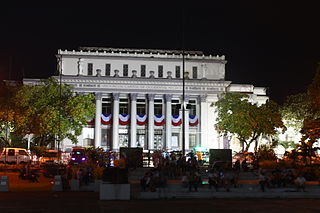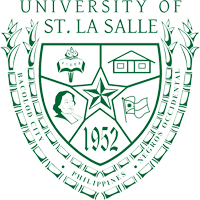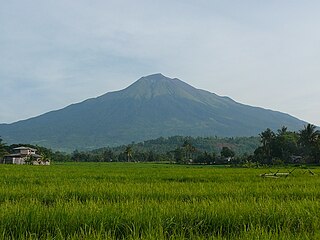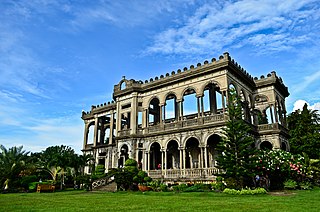
Negros Occidental, also known as Occidental Negros or Western Negros, is a province located in the region of Western Visayas, in the Philippines. It occupies the northwestern half of the large island of Negros, and borders Negros Oriental, which comprises the southeastern half. Known as the "Sugarbowl of the Philippines", Negros Occidental produces more than half the nation's sugar output.

Bacolod, officially the City of Bacolod and often referred to as Bacolod City, is a highly urbanized city in the Philippines. It is the capital of the province of Negros Occidental where it is geographically situated but governed administratively independent from it.

Silay, officially the City of Silay, or simply referred to as Silay City, is a 3rd class city in the province of Negros Occidental, Philippines. According to the 2015 census, it has a population of 126,930 people.

The University of St. La Salle (USLS) is a Catholic private research university run by the De La Salle Brothers, located in La Salle Avenue, Bacolod City, Philippines. Established in 1952 as La Salle College - Bacolod, it is the second oldest campus founded by the congregation in the country. The university is a member of De La Salle Philippines, a network established in 2006 comprising 16 Lasallian educational institutions in the country. The university offers preschool, elementary, secondary, undergraduate, and graduate programs. It has seven colleges namely: Business and Accountancy, Engineering and Technology, Arts and Sciences, Education, Nursing, Law, and Medicine.
Rolando Ramos Dizon is a Filipino De La Salle Brother who was the President of De La Salle University and the De La Salle University System from 1998–2003, Chairman of the Commission on Higher Education from March 2003 to September 2004, Director-at-Large of the Catholic Educational Association of the Philippines from 1998 to 2003, and Acting Brother Visitor of the De La Salle Brothers in the Philippines from 1976 to 1977 as well as a member of President Gloria Macapagal-Arroyo's Consultative Commission on Charter Change from September to October 2005.

The Republic of Negros was a short-lived cantonal revolutionary republic in the eponymous Visayan island, and later, an administrative division, which existed while the Philippines was under Spanish and American sovereignty.

The Negros Revolution, commemorated and popularly known as the Fifth of November or Negros Day, was a political movement that in 1898 created a government on Negros Island in the Philippines, ending Spanish control of the island and paving the way for a republican government run by the Negrense natives. The newly established Negros Republic lasted for approximately three months. American forces landed on the island unopposed on February 2, 1899, ending the island's independence. Negros was then annexed to the Philippine Islands on 20 April 1901.

The Mariano Ramos Ancestral House is the home of the late Mariano Ramos, first appointed Presidente Municipal of Bacolod City, Philippines. It was built in the 1930s and its architecture is a combination of Castilian and Tuscan and comprises three storeys including the tower room, known as the torre and it is beside the Dizon-ramos museum.

The Balay Negrense, also known as Victor Fernandez Gaston Ancestral House is a museum in Silay City, Negros Occidental in the Philippines, showcasing the lifestyle of a late 19th-century Negrense sugar baron. It is notable for being the first museum to be established in the province of Negros Occidental.

The Negrenses, or alternatively Negrosanons, are the native people and cultural group of the island of Negros. Years of migrations and intra-migrations in Negros have created a distinct blend of people, culture and languages, with the northwestern half, comprising Negros Occidental, having a Hiligaynon-speaking majority, while the southeastern half, comprising Negros Oriental, having a Cebuano-speaking majority. The indigenous Buglas Bukidnon and Ati peoples, with their interactions and intermarriage with recent migrants from Iloilo and Antique, use a variant of Kinaray-a mixed with Hiligaynon. The Bacolod Metropolitan Area is noted for its distinct dialect of Hiligaynon called Bacolodnon.

Ancestral houses of the Philippines or Heritage Houses are homes owned and preserved by the same family for several generations as part of the Filipino family culture. It corresponds to long tradition by Filipino people of venerating Ancestors and Elders. Houses could be a simple house to a mansion. The most common ones are the "Bahay na Bato". Some houses of prominent families had become points of interest or museums in their community because of its cultural, architectural or historical significance. These houses that are deemed of significant importance to the Filipino culture are declared Heritage House by the National Historical Commission of the Philippines (NHCP), previously known as the National Historical Institute (NHI) of the Philippines. Preservation is of utmost importance as some ancestral houses have come into danger due to business people who buy old houses in the provinces, dismantle them then sell the parts as ancestral building materials for homeowners wishing to have the ancestral ambiance on their houses. These ancestral houses provide the current generation a look back of the country's colonial past through these old houses.

Negros is the fourth largest island of the Philippines, with a land area of 13,309.60 km2 (5,138.87 sq mi). Negros is one of the many islands that comprise the Visayas, in the central part of the country. The predominant inhabitants of the island region are mainly called Negrenses. As of 2015, Negros' total population is 4,414,131 inhabitants.

Capitol Central, previously called the Negros Occidental Provincial Capitol Complex, is a government complex and mixed-use estate centered around the Negros Occidental Provincial Capitol, currently co-managed with Ayala Land. Certain portions are leased or sold to Ayala Land, as part of their industrial estate in Bacolod City, Philippines.

Negros Museum is a privately owned provincial museum situated in the Negros Occidental Provincial Capitol Complex in Bacolod City, Philippines. The structure was built in 1925 as the Provincial Agriculture Building.

Hacienda Rosalia, also known as Hacienda Santa Rosalia, is a compound where the ancestral home mansion of Gaston family and the Church of Cartwheels are located. It is situated in Manapla, Negros Occidental, Philippines. The mansion was built in 1930s.

The Ruins is the remains of the ancestral home mansion of the family of Don Mariano Ledesma Lacson and Maria Braga Lacson. It is situated in Talisay, Negros Occidental, Philippines. The mansion was built in early 1900s and inspired by Italian architecture.
The Museo Negrense de La Salle is located within the campus of the University of St. La Salle in Bacolod, Philippines beside the St. La Salle Coliseum. It is the only school-based museum in the Negros region.

The Silliman Hall is a building constructed in the Stick Style of American architecture in Dumaguete, Negros Oriental, Philippines. It was built in the early 1900s. It was converted to a museum in 1970. It is located in Dumaguete, Negros Oriental, Philippines.

Dr. Jose Corteza Locsin Ancestral House is a two-storey house built in the 1930s in Silay, Negros Occidental Philippines. It has been named as a Heritage Houses of the Philippines by the National Historical Commission of the Philippines.
















